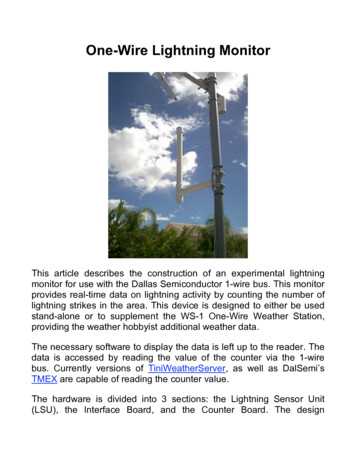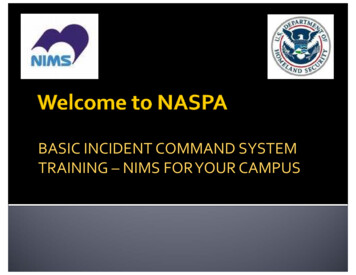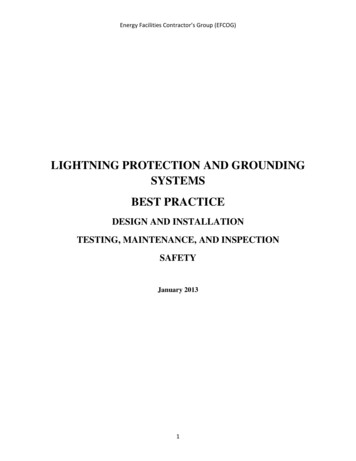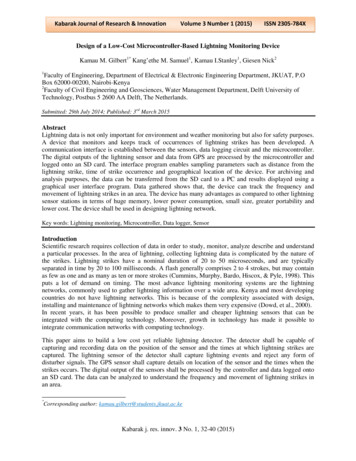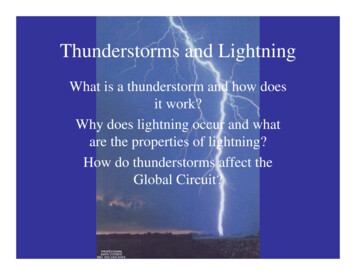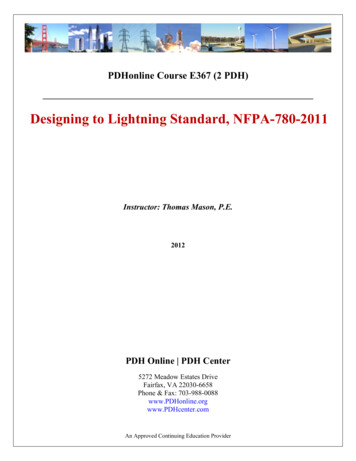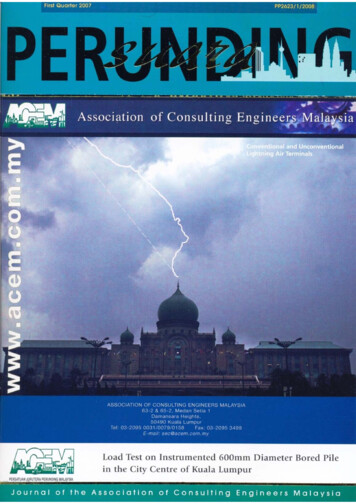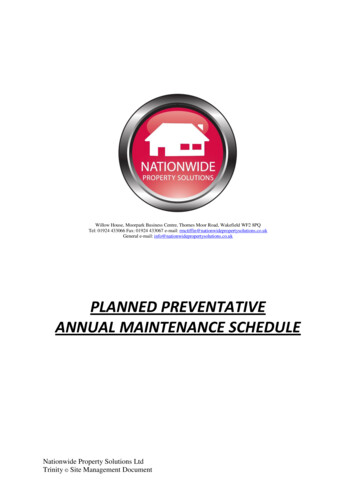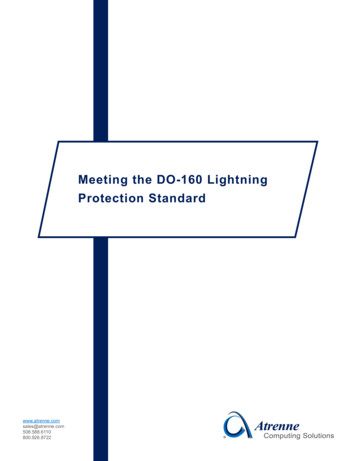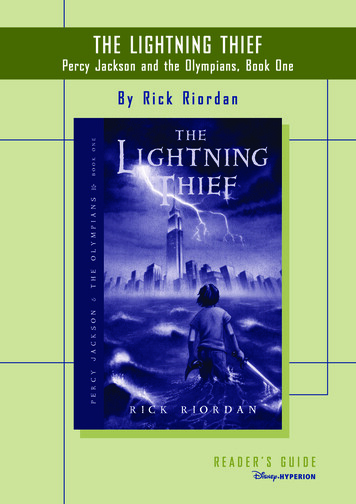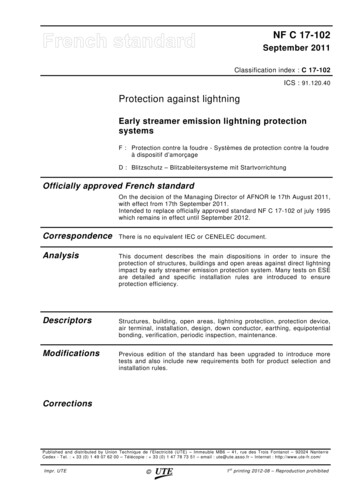
Transcription
NF C 17-102September 2011Classification index : C 17-102ICS : 91.120.40Protection against lightningEarly streamer emission lightning protectionsystemsF : Protection contre la foudre - Systèmes de protection contre la foudreà dispositif d’amorçageD : Blitzschutz – Blitzableitersysteme mit StartvorrichtungOfficially approved French standardOn the decision of the Managing Director of AFNOR le 17th August 2011,with effect from 17th September 2011.Intended to replace officially approved standard NF C 17-102 of july 1995which remains in effect until September 2012.CorrespondenceThere is no equivalent IEC or CENELEC document.AnalysisThis document describes the main dispositions in order to insure theprotection of structures, buildings and open areas against direct lightningimpact by early streamer emission protection system. Many tests on ESEare detailed and specific installation rules are introduced to ensureprotection efficiency.DescriptorsStructures, building, open areas, lightning protection, protection device,air terminal, installation, design, down conductor, earthing, equipotentialbonding, verification, periodic inspection, maintenance.ModificationsPrevious edition of the standard has been upgraded to introduce moretests and also include new requirements both for product selection andinstallation rules.CorrectionsPublished and distributed by Union Technique de l'Electricité (UTE) – Immeuble MB6 – 41, rue des Trois Fontanot – 92024 NanterreCedex - Tel. : 33 (0) 1 49 07 62 00 – Télécopie : 33 (0) 1 47 78 73 51 – email : ute@ute.asso.fr – Internet : http://www.ute-fr.com/Impr. UTE 1 st printing 2012-08 – Reproduction prohibited
NF C 17-102–2–UTE has taken all reasonable measuresto ensure the accuracy of this translationbut regrets that no responsibility can be acceptedfor any error, omission or inaccuracy.In cases of doubt or dispute,the original language text only is valid.
–3–NF C 17-102FOREWORDThere is no international standard or specific European standard about early streamer emissionlightning protection systemsThis document is intended to replace the 1995 edition of the NF C 17-102, with its secondprinting in 2009.This document specifies requirements for design, in the present state of knowledge andtechnology, protection against lightning of structures (buildings, fixtures, etc.) and open areas(storage areas, rest areas or sports, etc.) by early streamer emission lightning protectionsystems and provides guidance on how to achieve this protection .Installations for protection against lightning designed and made according to this document,may not, like everything about the natural elements, ensure the absolute protection ofstructures, people or objects; however, the application of this document must reducesignificantly the risk of damage due to lightning on protected structures.The provisions stated in this document are minimum requirements to ensure statistically aneffective protection.This new edition is a complete revision of the standard following the publication of the Europeanstandard series EN 62305 and more particularly to the EN 62305-3 giving the requirements forprotection of structures against lightningHowever, the EN 62305 series is not dealing with early streamer emission technology, therevision of the NF C 17-102 appeared essential to provide the design requirements of an earlystreamer emission air terminal and those for implementing the ESE lightning protection system.In order to have no conflict with the European standard series, this document makes noreference to it, but repeats the necessary arrangements for the design and creation of thelightning protection system.The UTE has established the following dates:- Date on which the previous national standard will be canceled: September 2012;- Date of cessation of presumption of conformity of products manufactured under thesuperseded standard: September 2012.This document was approved June 28, 2011 by the Commission UF81, Protection againstlightning.
NF C 17-102–4–CONTENTS1Scope . 92Normative and regulation references . 93Definitions . 114Lightning protection system with Early Streamer Emission Air Terminal . 1654.1 Need of protection . 164.2 Components of the lightning protection system . 16Early streamer emission lightning protection system . 185.15.26Design . 18Early Streamer Emission Terminal . 185.2.1 General principles . 185.2.2 ESEAT efficiency . 185.2.3 Positioning of the ESEAT . 185.2.4 Materials and dimensions. . 215.2.5 Installation . 215.3 Down-conductors . 225.3.1 General principles. . 225.3.2 Number of down-conductors. . 225.3.3 Routing . 235.3.4 Indoor routing . 245.3.5 Outside cladding . 245.3.6 Materials and dimensions. . 245.3.7 Test joint. . 255.3.8 Lightning event counter. . 255.3.9 Natural components. . 255.4 Equipotential bonding of metal parts . 265.4.1 General . 265.5 Lightning equipotential bonding . 265.5.1 General . 265.5.2 Lightning equipotential bonding for metal installations . 265.5.3 Lightning equipotential bonding for external conductive parts . 275.5.4 Lightning equipotential bonding for internal systems . 275.5.5 Lightning equipotential bonding for lines connected to the structure to beprotected . 285.6 Electrical insulation of the external ESESystem . 28Earth termination systems . 3076.1 General . 306.2 Earth termination system types . 316.3 Additional measures . 336.4 Earthing equipotentiality . 336.5 Proximity requirements . 346.6 Materials and dimensions . 34Special measures . 3487.1 Aerials . 347.2 Inflamable and explosive material storage areas . 347.3 Religious buildings . 34Execution file, vérification and maintenance . 35
F C 17-102Execution File . 35Orders of Verifications . 36Verification report . 36Initial verification . 36Visual verification . 37Complete verification . 37Maintenance . 37A(normative) RISK ANALYSIS . 38Explanation of terms . 38A.1.1 Damage and loss . 38A.1.2 Risk and risk components . 39A.1.3 Composition of risk components related to a structure . 41Risk management . 42A.2.1 Basic procedure . 42A.2.2 Structure to be considered for risk assessment . 42A.2.3 Tolerable risk R T . 42A.2.4 Specific procedure to evaluate the need of protection . 42A.2.5 Procedure to evaluate the cost effectiveness of protection . 43A.2.6 Selection of protection measures . 43Assessment of risk components for a structure . 45A.3.1 Basic equation . 45A.3.2 Assessment of risk components due to flashes to the structure (S1) . 45A.3.3 Assessment of the risk component due to flashes near the structure (S2) . 45A.3.4 Assessment of risk components due to flashes to a line connected to the structure(S3) . 46A.3.5 Assessment of risk component due to flashes near a line connected to thestructure (S4) . 46A.3.6 Summary of risk components in a structure . 47A.3.7 Partitioning of a structure in zones Z S . 47A.3.8 Assessment of risk components in a structure with zones Z S . 48Assessment of annual number N of dangerous events . 49A.4.1 General . 49A.4.2 Assessment of the average annual number of dangerous events due to flashes toa structure N D and to a structure connected at “a” end of a line N Da . 50A.4.3 Assessment of the average annual number of dangerous events due to flashesnear a structure N M . 54A.4.4 Assessment of the average annual number of dangerous events due to flashes toa service N L . 54A.4.5 Assessment of average annual number of dangerous events due to flashes near aservice N I . 55Assessment of probability P X of damage for a structure . 56A.5.1 Probability P A that a flash to a structure will cause injury to living beings . 56A.5.2 Probability P B that a flash to a structure will cause physical damage . 57A.5.3 Probability P C that a flash to a structure will cause failure of internal systems . 57A.5.4 Probability M P that a flash near a structure will cause failure of internal systems . 58A.5.5 Probability P U that a flash to a service will cause injury to living beings . 59A.5.6 Probability P V that a flash to a service will cause physical damage . 60A.5.7 Probability P W that a flash to a service will cause failure of internal systems . 60A.5.8 Probability P Z that a lightning flash near an incoming service will cause failure ofinternal systems . 60
NF C 17-102–6–Assessment of amount of loss L X in a structure . 61A.6.1 Average relative amount of loss per year . 61A.6.2 Loss of human life . 61A.6.3 Unacceptable loss of service to the public . 64A.6.4 Loss of irreplaceable cultural heritage . 64A.6.5 Economic loss . 65ANNEXE B (normative) N g maps . 66A.6ANNEXE C(Normative) ESEAT testing procedures and requirements . 67C.1C.2C.3C.4C.5AnnexeOperation conditions . 67C.1.1 Normal conditions . 67C.1.2 Abnormal conditions . 67Requirements . 67C.2.1 General requirements . 67C.2.2 Requirements for early streamer emission . 67C.2.3 Electrical requirements . 67C.2.4 Mechanical requirements . 67C.2.5 Environmental requirements . 68C.2.6 Electromagnetic compatibility . 68Type test . 69C.3.1 General tests . 70C.3.2 Mechanical tests . 70C.3.3 Environmental conditioning . 70C.3.4 Current withstanding tests . 70C.3.5 Early streamer emission tests . 71Structure and content of the test report . 77Care and maintenance of the ESEATs . 78D (Normative) Protection of people against electrical shocks caused by lightning . 79D.1Protection measures against injury to living beings due to touch and step voltages . 79D.1.1 Protection measures against touch voltages . 79D.1.2 Protection measures against step voltages . 79Annexe E (Informative) Example of values of coefficient k c . 80Bibliographie . 82Figures :Figure 1 – Components of the lightning protection system . 17Figure 2 – Protection Radii (with hypothesis h 1 5 m) . 19Figure 3 - Additional protection against direct lightning strike for the highest 20% of the structureheight for buildings taller than 60 m . 21Figure 4 – Down-conductor bend shapes . 23Figure 5 – Illustrations of the separation distance according to the length in question and theincrease in potential difference as a function of the distance at the nearest equipotential point(P) . 29Figure 6 – Scheme of earthing types A1 and A2 . 32Figure 7 - Religious buildings . 35Figure A.1 – Procedure for selecting protection measures in structures . 44Figure A.2 – Structures at line ends: at “b” end the structure to be protected (structure b) and at “a”end an adjacent structure(structure a) . 47
–7–NF C 17-102Figure A.3 – Collection area Ad of an isolated structure . 50Figure A.4 – Complex shape structure . 51Figure A.5 – Different methods to determine the collection area for the structure of Figure A.4 . 52Figure A.6 – Structure to be considered for evaluation of collection area A d . 53Figure A7 – Collection areas (A d , A m , A i , A l ) . 56Figure B.1 – Map of N k level, (N k 10xN g ) for France . 66Figure C.1: Sequence of testing . 69Figure C.2 - Reference single rod air terminal (SRAT) . 71Figure C.3 – Experimental set-up of the SRAT . 72Figure C.4 – Experimental set-up of the ESEAT . 72Figure C.5 – Reference wave . 75Figure C.6 - Graphic correction principle . 76Figure E.1 – In the case of numerous ESE interconnected at roof level and type B earth-terminationsystem. 80Figure E.2 – Examples of calculation of the separation distance in the case of downconductors aninterconnected by rings. . 81Tables :Table 1 – Minimum dimensions of conductors connecting different bonding bars or connectingbonding bars to the earth-termination system . 27Table 2 – Minimum dimensions of conductors connecting internal metal installations to the bondingbar . 27Table 3 – Isolation of external ESESystem – Values of coefficient k i . 29Table 4 – Isolation of External ESESystem – Values of coefficient k m . 29Table 5 – Isolation of external ESESystem – Values of coefficient k c . 30Table 6 – Typical resistivity soil . 32Table 7 – Periodicity of inspection regarding the protection level . 36Table A.1 – Sources of damage, types of damage and types of loss according to the point of strike . 39Table A.2 – Risk components to be considered for each type of loss in a structure . 41Table A.3 – Typical values of tolerable risk R T . 42Table A.4 – Risk components for a structure for different types of damage caused by differentsources . 47Table A.5 – Location factor C d . 53Table A.6 – Collection areas A l and A i depending on the service characteristics . 55Table A.7 – Transformer factor C t . 55Table A.8 – Environmental factor C e . 56Table A.9 – Values of probability P A that a flash to a structure will cause shock to living beings dueto dangerous touch and step voltages . 57Table A.10 – Values of P B depending on the protection measures to reduce physical damage . 57Table A.11 – Value of the probability P SPD as a function of LPL for which SPDs are designed . 57Table A.12 – Value of the probability P MS as a function of factor K MS . 58Table A.13 – Value of factor K S3 depending on internal wiring . 59Table A.14 – Values of the probability P LD depending on the resistance R S of the cable screen andthe impulse withstand voltage U w of the equipment . 60
NF C 17-102–8–Table A.15 – Values of the probability P LI depending on the resistance R S of the cable screen andthe impulse withstand voltage U w of the equipment . 61Table A.16 – Typical mean values of L t , L f and L o . 62Table A.17 – Values of reduction factors r a and r u as a function of the type of surface of soil or floor 62Table A.18 – Values of reduction factor r p as a function of provisions taken to reduce theconsequences of fire . 63Table A.19 – Values of reduction factor r f as a function of risk of fire of structure . 63Table A.20 – Values of factor h z increasing the relative amount of loss in presence of a specialhazard . 63Table A.21 – Typical mean values of L f and L o . 64Table A.22 – Typical mean values of L t , L f and L o . 65Table C.1 – Material, setup and minimum area of the striking point part's body . 68Table C.2 – Value of current I imp . 71Table C.3 – Variation of the climatic parameters during the tests. 73
–9–NF C 17-102Early streamer emission Lightning protection systems1ScopeThis standard is applicable to early streamer emission lightning protection systems provided to protectfacilities and open areas against direct lightning impact. This ESESystem shall be tested, selected andinstalled according to the present standard.2Normative and regulation referencesThe following standards include provisions which, through reference in this text, are necessary toimplement this standard. For dated references, only the adverted version is applicable. For non-datedreferences, the last edition of the reference is applicable (comprinsing possible amendments).CLC/TS 61643-12Low-voltage surge protective devices -- Part 12: Surge protective devicesconnected to low-voltage power distribution systems - Selection andapplication principlesEN 50164(Series)Lightning protection system components -EN 50164-2(C 17-151-2)Lightning protection system components - Requirements for conductors andearth electrodesEN 50164-3(C 17-151-3)Lightning protection system components - Requirements for isolating sparkgapsEN 50164-5(C 17-151-5)Lightning protection system components -EN 50164-6(C 17-151-6)Lightning protection system components - Requirements for lightning strikecounters (LSC)EN 50164-7(C 17-151-7)Lightning protection systemenhancing compoundsIEC 60060-1(C 41-100-1)High-voltage testrequirementsEN 60068-2-52(C 20-752)Environmental testing -- Part 2: Tests - Test Kb: Salt mist, cyclic (sodiumchloride solutionEN 60079-10(C 23-579-10)(Série)Electrical apparatus for explosive gas atmospheresEN 61000-6-2(C 91-006-2)Electromagnetic compatibility (EMC) -- Part 6-2: Generic standards - Immunityfor industrial environmentsEN 61000-6-3(C 91-006-3)Electromagnetic compatibility (EMC) -- Part 6-3: Generic standards - Emissionstandard for residential, commercial and light-industrial environmentsEN 61180-1(C 41-106)High-voltage test techniques for low-voltage equipment -- Part 1: Definitions,test and procedure requirementsEN 61241-10(C 23-241-10)Electrical apparatus for use in the presence of combustible dust -- Part 10:Classifi
September 2011 Classification index : C 17-102 ICS : 91.120.40 Protection against lightning Early streamer emission lightning protection systems F : Protection contre la foudre - Systèmes de protection contre la foudre à dispositif d'amorçage D : Blitzschutz - Blitzableitersysteme mit Startvorrichtung Officially approved French standard
